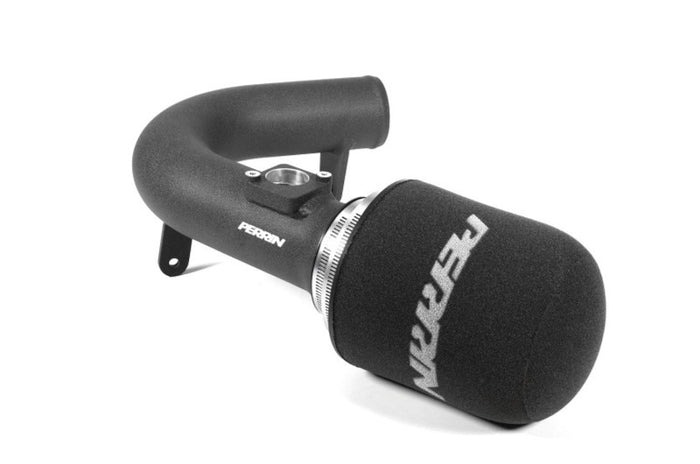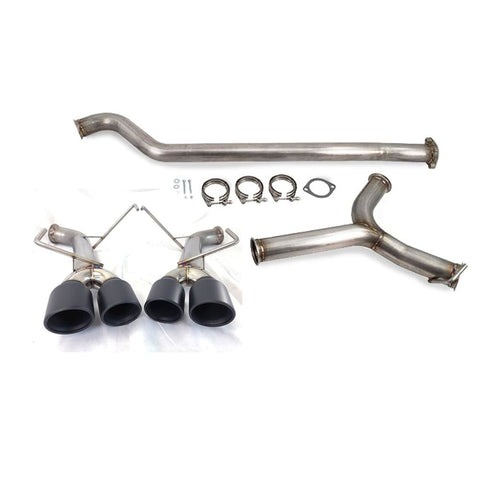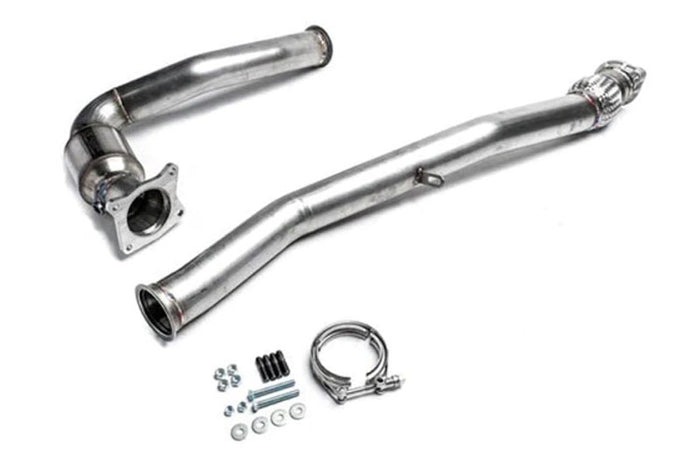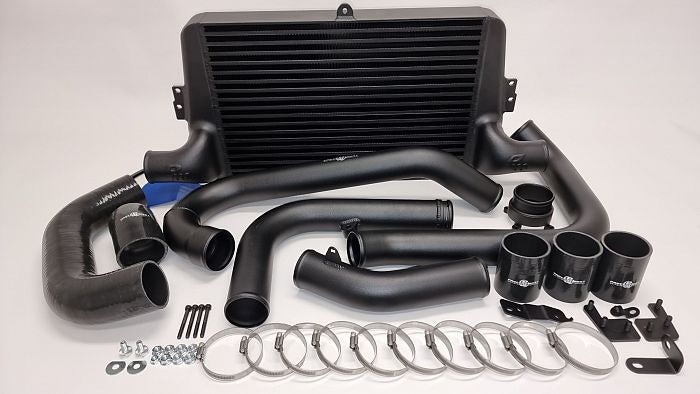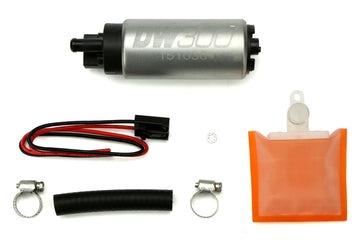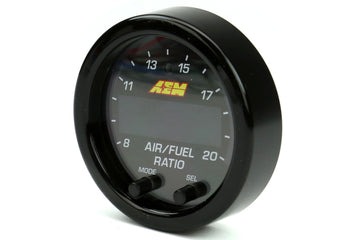Can You Make 450 HP In The 2022+ WRX?
29 MAR 2024 - Jeff Willis
DISCLAIMER:
This blog is about how others have achieved nearly 450 HP, and in some cases beyond in the VB Subaru WRX. It is for entertainment and in some cases, educational purposes. There is the risky way to make 450 HP in a Subaru, and there is a right way. Because the FA24F is still a fairly new platform, and since it has been out for two years, there have been shops that have raced to try and make the most horsepower out of the FA24F. There are many factors on how these numbers were achieved, but going back to risky vs right, these mods are shortcuts to 400+, and is no way, shape, or form, reliable. If you choose to try to make these numbers out of your own VB WRX, we are not responsible for any blown motors. It is just an article on how it can be done. In one way or another.
THE ROADMAP TO 300 HP
(Cobb Tunning Accessport 22+WRX)
Just like any previous WRX model, the 2022+ WRX highly benefits from a COBB Accessport. The Accessport has been a staple inside the WRX and STI for the last 20+ years. This is a handheld tuning device that works with your factory ECU to send signals and change parameters whenever mods such as a cold air intake, exhaust, or other mods are added. Anytime you try to add upgrades that increase the power, this means that the turbo will react faster which will spike the boost levels outside of the ECUs factory programming. When this happens, your Subaru will actually run worse. A cold air intake will allow the turbo to inhale a larger volume of air, and when the MAF doesn’t recognize this larger volume, the fuel tables can only compensate for so much and the check engine light can come on, and you could have boost cut under full throttle. Now this does not apply to all cold air intake systems as there are examples that are designed to bolt right in, without triggering any check engine lights. A tune would also be needed for a J-pipe aka downpipe. Typical aftermarket examples will have around a 3-inch piping diameter with smooth bends. This allows the turbo to react much faster and will create more boost than what the OEM boost solenoid is programmed to do. There are many available off the shelf MAPS for the Accessport to download to work with any current or future modifications, and to make sure your WRX is running right with pump gas, or E85.
COLD AIR INTAKE
(PERRIN Cold Air Intake 22+ WRX)
As mentioned, a proper cold air intake is necessary to make more power in the FA24F. The reason why aftermarket intakes create more power, is that they replace your highly restrictive airbox. The turbo has to suck air through a paper filter which is susceptible to trapping in more dirt and debris. A cold air intake features a larger cone-style filter that provides a much larger surface area for the turbo to breathe. When the turbo can breathe better the throttle response is highly improved, and you will make more horsepower and torque. And this is why cold air intake systems work really well with an upgraded exhaust system. A performance intake allows the engine to breath much easier, while an upgraded exhaust system allows the engine to exhale much faster.
CAT-BACK EXHAUST SYSTEM
An aftermarket cat-back exhaust system is one of, if not the most popular upgrade to any car worth making power. Not only do you make more power and torque, but the fun part is in the sound, especially in a Subaru boxer 4-cylinder. The factory muffler in the VB WRX is heavy, and has to be compliant across the board in terms of noise ordinances, manufacturing costs, and a good medium of performance and sound. This is just another way to say that there is a lot left on the table for improvement. Performance gains are had by two main elements, and that is larger piping with as minimal bends as possible. This reduces turbulence to allow an unobstructed path for the exhaust gases. When applying full throttle, this will allow for a faster throttle response. Additionally, cat-back exhaust systems are one of the easiest modifications to perform along with a cold air intake. If you’re mechanically inclined enough and have basic garage tools, you can install one yourself with the rear end safely supported on jack stands.
MOVING UPWARD TO 350 HP
Now with the mods mentioned above, it is possible to make 350 Hp with a decent tune. However, you want to keep things safe. The numbers matter, but they should not be the main goal here even though the point of this blog is to make a certain power goal. Making sure your engine actually lasts should be your number one priority. And stretching your tune and powerband thin is a quick way to lean out your motor. In order to achieve 350 HP, the next logical step is to upgrade to a J-pipe, as well as improving your cooling efficiency with a larger intercooler core. Also known as a downpipe, the FA20F in the 2015-2021 WRX, as well as the FA24F in 2022+ WRX models have a downpipe shaped like a J, and really frees up the exhaust flow when compared to the factory unit. When combined with a proper tune, you get a really nice bump in power. Most importantly, it must be used in conjunction with a proper aftermarket cat-back system. If you try and upgrade your J-pipe as your first exhaust upgrade, then the smaller piping diameter on your factory cat-back will act as a bottleneck. This is why it is important to always upgrade your cat-back first, to allow your exhaust gases to flow faster out of the back rather than generating more turbulence between the J-pipe and cat-back mating area.
HEAT SOAK HAS ENTERED THE CHAT
(Process West FMIC Kit 22+ WRX)
When modifying any generation of WRX that adds more horsepower and more boost, this means that the turbo will spin faster as restrictions lift. A cold air intake and cat-back exhaust increase the flowing efficiency of the turbocharger, but your power will hit a ceiling with the factory top mount intercooler. Subaru uses a top mount intercooler setup. The compressor side of the turbocharger blows air into the intercooler core where the job of the intercooler must lower the intake charge temperatures before exiting into the intake manifold. The problem is that the intercooler is mounted just above the turbocharger where the exhaust housing generates a lot of heat. In summer temperatures, or if you’re enjoying a weekend track event where the engine is living in the upper RPM range, your factory top-mount intercooler can get so hot that it fails to lower those intake charge temperatures, thus blowing warm air into the intake. When this happens, you put a limit on the power potential of your engine, as well as the rest of the modifications you have on your Subaru.
You can resort to a larger top mount intercooler cooler core, which most aftermarket units are good to about 400 HP. But since this article is about trying to get to these higher levels of power, you will want to resort to a front mount intercooler setup. The intercooler core on a FMIC setup will obviously be larger, but more importantly, it is highly exposed to incoming air making direct contact with the face of the intercooler, rather than relying on a narrow slot on your hood scoop. Are there any drawbacks to a front mount intercooler setup? Purists who don’t like power will say that there is a little bit of a lag difference because of the extra piping that is routed to the turbo and to the intake. But this is hardly the case with the FA24F since the turbo is mounted on the lower side of the engine, and it will be required anyways if you are trying to make big numbers. And in some cases, an overly large intercooler core could hinder the airflow going to your radiator.
CLEARING THE PATH TO 400 HP, YOU MUST UPGRADE YOUR FUEL SYSTEM
(DeatschWerks DW300 Fuel Pump Universal)
Your fuel system is one of the most important upgrades that you need to perform even when making 300 HP. Although cat-back systems, J-pipes, tunes, and intercoolers take up the most real estate in the sensory overload aspect of the car, fuel is right up there with the tune. If you don’t have a big enough fuel pump, if you don’t have a big enough injector, then you are limited in boost and power, and if you drive irresponsibly, you will melt your motor. So, when we mention “leaning out the motor”, what does this mean? This means that you are not getting enough fuel to your cylinders which will greatly increase the cylinder temperatures, exhaust gas temperatures, and you’re running too much boost with not enough fuel to compensate. Having enough fuel to maintain a proper air/fuel ratio under boost won’t melt your pistons, damage ring lands, and fight detonation issues. Also making sure you have the right tune for the type of fuel you are running is also highly important. This is why a flex fuel system is very important for ease of use, and for the overall convenience of it as your tune will automatically adjust for the level of ethanol you have in your fuel tank.
An upgraded fuel pump should be the first upgrade you perform, as they will increase and maintain a higher flow volume to your injectors. The OEM fuel pump is designed to only pump out so many LPH (liters per hour), and an aftermarket fuel pump will make sure you are not starving your engine of fuel during boost.
Larger injectors although limited for the FA24F as it’s still in the new phase, are a must if you are running more boost or running ethanol. Ethanol can be corrosive, and certain materials used must sustain ethanol. But more importantly, you need to run a higher injector duty cycle to run ethanol, which is very limited on stock injectors. A 1000CC injector size is a good choice for those of you who are shooting for that 450 HP goal.
THE RIGHT SPARK PLUG
This one is short and sweet. But the more power you are making, the more demand you will have from your ignition system. Your stock ignition coils should be okay for 400 HP, but you need to upgrade to a one-step colder range spark plug, and depending on your elevation, boost levels, or fuel type, you may have to gap your spark plugs down further if you’re experiencing spark plug breakup.
THE RIGHT CLUTCH
As you can see in the video, SubiSpeed’s 2022+ WRX made 245 WHP, and 253 WTQ. The clutch supplied from the factory has been designed to be sufficient for OEM power levels. When you start getting over 300-wheel HP, you will start to cook your OEM clutch disc, and over 350-wheel HP, you are certainly going to burn through your OEM disc, or glaze the flywheel, killing any friction for the clutch. An aftermarket clutch whether it be a single-disc clutch with a heavy-duty pressure plate, or a multi-disc clutch with more clutch discs provide a higher clamping force to support higher power levels. When choosing the right clutch for your setup, make sure you research the torque rating of that clutch, and make sure it is rated for 400–500-wheel torque so that you are not experiencing any slippage issues on the street, or on the dyno.
MAKE SURE YOU HAVE A WIDEBAND O2 GAUGE
(AEM Wideband O2 Gauge Universal)
A wideband O2 gauge is a tool for the tuner, and insurance for you and your motor. Under wide open throttle, if the display on the gauge is reading 12.0 AFRs or higher at the top of boost, you’re running too lean, and you need to get off the throttle and check things out. You could have dirty injectors, a weak fuel pump, or your fuel is bad. If you continue to drive under lean conditions, you will melt your motor. You want to make sure that at the top of boost you want your AFRs to read from 10.8-11.8 which is the strike zone. Anything richer than that, this means that you could have a blown intercooler pipe, a major boost leak, too much fuel getting into the cylinders so check the fuel pressure settings if you have an aftermarket regulator. Or you could be having too much blow-by in the cylinders and in this case, something definitely needs to be checked out. It could be worn piston rings, or you need to check your air/oil separator.
THE TUNE – CHOOSE WISELY

The tune is very imperative to a properly running engine. Whether if an experienced tuner tries to tune through a standalone unit, the COBB Accessport, or tries reprogramming the stock ECU through a flash tune, make sure you research who you employ to tune your Subaru.
BIG HORSEPOWER NUMBERS DOES NOT EQUAL A SUCESSFUL TUNER

Again, you do things cheap, or you do things right. We have all heard horror stories about how a local tuner in your area made big horsepower on someone’s Subie, only to have the car blow up a few weeks later. How does this happen, and how is this a normal occurrence with certain tuners? This happens by trying to make as much horsepower on the dyno as possible to satisfy the customer. In most cases, too much timing is added to the top of the tune. Meaning that the ignition timing is too advanced, and will exceed the limits of your short block, as well as the drivetrain. If an engine blows on the dyno, or a week later the street, this means that thousands of dollars will need to be spent to get your car back on the road, and then the blame game starts. The tuner will say that there was something already internally wrong with your car, and you will say that the car was fine before you took it to said tuner. And truthfully, both sides have a strong argument.
Making sure that your Subaru is 100% fully copesetic prior to tuning or dyno time needs to be locked down. This means that your compression must be solid across all cylinders. You need to have the right spark plugs. You need to make sure you don’t have any boost leaks, and you need to make sure your fluids are fresh, especially the oil. You need to make sure that your cooling components are working as they should, and that your clutch is not showing signs of slippage. What needs to be known, is that if something suddenly changes in your car, your tune won’t just magically change. Something is wrong with your car, and you need to go over everything before you call your tuner. Granted a tuner can certainly help you narrow down what is happening, but more than likely it will be a mechanical issue.
SWING FOR THE FENCES

Going back to the beginning disclaimer, we are not responsible on your quest to making 450 HP on the stock FA24F internals. Has it been done? Yes, it has. But in all reality, and just learning from history, there hasn’t been an EJ or an FA that can handle 400 HP to the wheels for long periods of time without something internally letting go. The silver lining is that the FA24F is still a new platform. Subaru could have learned the weak points of the FA20F and reinforced them. However, there are many variables on how an engine will last whether built to the moon, or unopened from the factory. And that is your driving habits. Just because you have forged pistons and rods, does not mean your engine is going to last much longer than factory guts. Purpose-built race cars last because they are built to survive arduous conditions, and they are tuned well below their boost or power thresholds. You can have a drag car making 40 lbs. of boost, but they are designed to make the fastest drag pass from 10 seconds and below.
If you just spent 40 thousand dollars for example, and you send your Subaru out to a preferred shop, and they did all the heavy lifting, installed a fully forged motor with a standalone, even with fail safes in place, and you get the car back and decide to do pull, after pull, after pull, without giving your motor a chance to cool down. Or if you’re at a car show and you keep bounding off the rev limiter trying to make flames out of your exhaust, your valves will be red hot and will chip at the edges. Irresponsible driving, irresponsible maintenance by not changing your oil when you should, or checking your plugs, or not running the right fuel will result in an injured motor. And shops will more than likely not be responsible unless they did something negligible that can undoubtedly be proven.
It is possible to have a 400+ HP Subaru on a stock engine, but just be sensible. Make sure that you have the fuel supply needed, make sure your tune and AFRs are always in the strike zone, and make sure everything else in the engine is working as it should, and you can enjoy a weekend at the drag strip making hits or having the occasional highway pull for your own personal enjoyment. Don’t be irresponsible, race cars break, the goal is to last.

